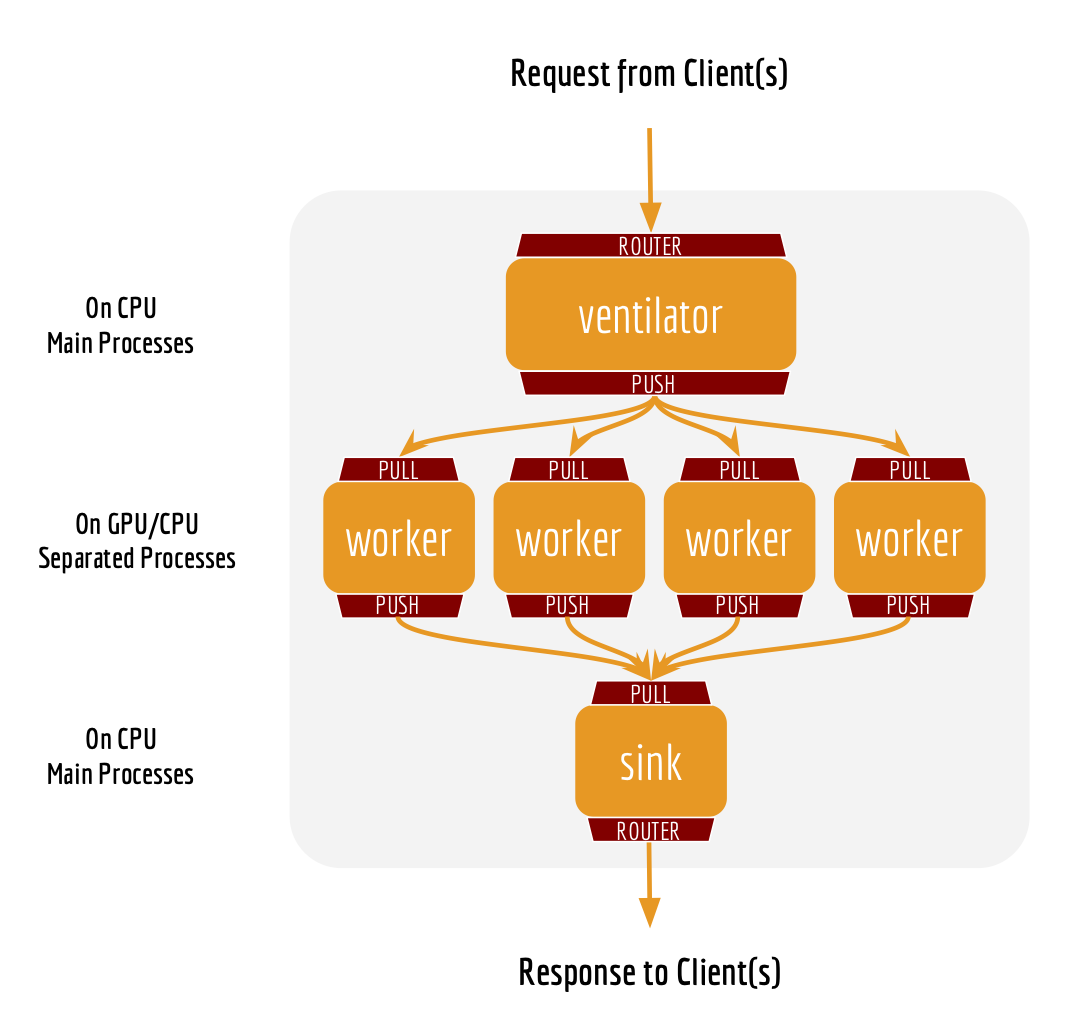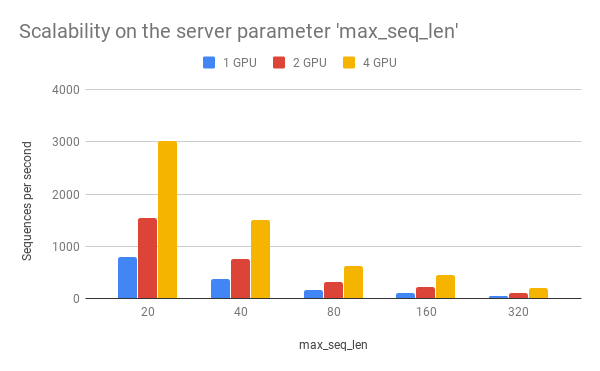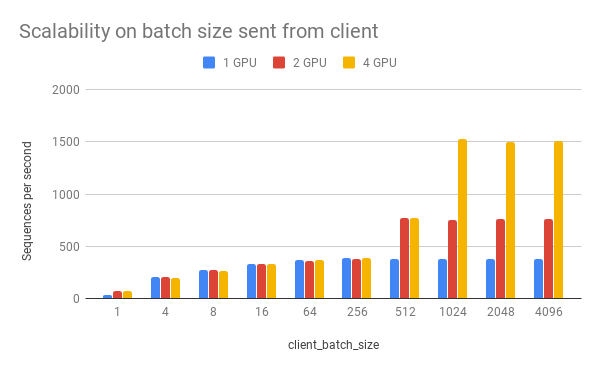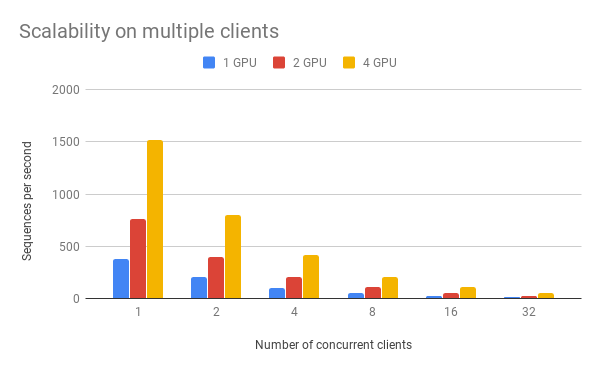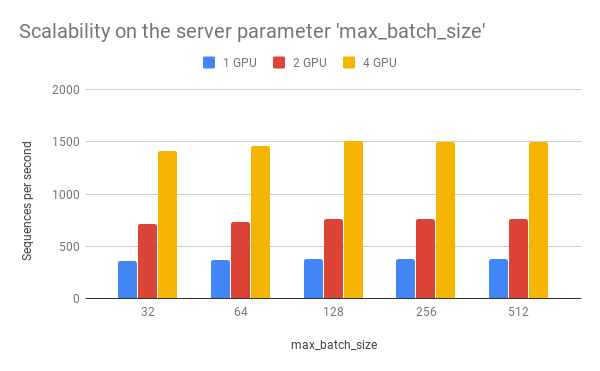bert-as-service
Using BERT model as a sentence encoding service, i.e. mapping a variable-length sentence to a fixed-length vector.
Author: Han Xiao https://hanxiao.github.io
BERT code of this repo is forked from the original BERT repo with necessary modification, especially in extract_features.py.
What is it
BERT: Developed by Google, BERT is a method of pre-training language representations. It leverages an enormous amount of plain text data publicly available on the web and is trained in an unsupervised manner. Pre-training a BERT model is a fairly expensive yet one-time procedure for each language. Fortunately, Google released several pre-trained models where you can download from here.
Sentence Encoding/Embedding: sentence encoding is a upstream task required in many NLP applications, e.g. sentiment analysis, text classification. The goal is to represent a variable length sentence into a fixed length vector, e.g. hello world to [0.1, 0.3, 0.9]. Each element of the vector should "encode" some semantics of the original sentence.
Finally, this repo: This repo uses BERT as the sentence encoder and hosts it as a service via ZeroMQ, allowing you to map sentences into fixed-length representations in just two lines of code.
Highlights
🔭 State-of-the-art: build on pretrained 12/24-layer BERT models released by Google AI, which is considered as a milestone in the NLP community.🐣 Easy-to-use: require only two lines of code to get sentence encodes.⚡ Fast: 780 sentences/s on a single Tesla M40 24GB whenmax_seq_len=20. See benchmark.🐙 Concurrency: scale nicely and smoothly on multiple GPUs and multiple clients. See benchmark.
Requirements
- Python >= 3.5 (Python 2 is NOT supported!)
- Tensorflow >= 1.10
These two requirements MUST be satisfied. For other dependent packages, please refer to requirments.txt and requirments.client.txt.
Usage
1. Download a Pre-trained BERT Model
Download a model from here, then uncompress the zip file into some folder, say /tmp/english_L-12_H-768_A-12/
You can use all models listed, including BERT-Base, Multilingual and BERT-Base, Chinese.
2. Start a BERT service
python app.py -model_dir /tmp/english_L-12_H-768_A-12/ -num_worker=4 This will start a service with four workers, meaning that it can handle up to four concurrent requests. More concurrent requests will be queued in a load balancer. Details can be found in our FAQ and the benchmark on number of clients
3. Use Client to Get Sentence Encodes
🚸 NOTE: please make sure your project includesclient.py, as we need to importBertClientclass from this file. This is the only file that you will need as a client. You don't even need Tensorflow on client.
Now you can use pretrained BERT to encode sentences in your Python code simply as follows:
from service.client import BertClient
bc = BertClient()
bc.encode(['First do it', 'then do it right', 'then do it better'])This will return a ndarray, in which each row is the fixed representation of a sentence. You can also let it return a pure python object in the type of List[List[float]].
Using BERT Service Remotely
One can also start the service on one (GPU) machine and call it from another (CPU) machine as follows
# on another CPU machine
from service.client import BertClient
bc = BertClient(ip='xx.xx.xx.xx', port=5555) # ip address of the GPU machine
bc.encode(['First do it', 'then do it right', 'then do it better'])
🚸 NOTE: please make sure your project includesclient.py, as we need to importBertClientclass from this file. Again, this is the only file that you need as a client. You don't even need Tensorflow. Please refer torequirements.client.txtfor the dependency on the client side.
Run BERT Service on Nvidia Docker
docker build -t bert-as-service -f ./docker/Dockerfile .
NUM_WORKER=1
PATH_MODEL=<path of your model>
docker run --runtime nvidia -dit -p 5555:5555 -v $PATH_MODEL:/model -t bert-as-service $NUM_WORKERServer and Client Configurations
Server-side configs
Server-side configs are summarized below, which can be found in app.py as well.
| Argument | Type | Default | Description |
|---|---|---|---|
model_dir |
str | folder path of the pre-trained BERT model. | |
max_seq_len |
int | 25 |
maximum length of sequence, longer sequence will be trimmed on the right side. |
num_worker |
int | 1 |
number of (GPU/CPU) worker runs BERT model, each works in a separate process. |
max_batch_size |
int | 256 |
maximum number of sequences handled by each worker, larger batch will be partitioned into small batches. |
port |
int | 5555 |
port for client-server communication. |
pooling_strategy |
str | REDUCE_MEAN |
the pooling strategy for generating encoding vectors, valid values are NONE, REDUCE_MEAN, REDUCE_MAX, REDUCE_MEAN_MAX, CLS_TOKEN, FIRST_TOKEN, SEP_TOKEN, LAST_TOKEN. Explanation of these strategies can be found here. To get encoding for each token in the sequence, please set this to NONE. |
pooling_layer |
int | -2 |
the encoding layer that pooling operates on, where -1 means the last layer, -2 means the second-to-last, etc. |
Client-side configs
Client-side configs are summarized below, which can be found in client.py as well.
| Argument | Type | Default | Description |
|---|---|---|---|
ip |
str | localhost |
IP address of the server |
port |
int | 5555 |
port of the server |
output_fmt |
str | ndarray |
the output format of the sentence encodes, either in numpy array or python List[List[float]] (ndarray/list) |
show_server_config |
bool | True |
whether to show server configs when first connected |
FAQ on Technical Details
Q: How large is a sentence vector?
Each sentence is translated to a 768-dimensional vector. One exception is REDUCE_MEAN_MAX pooling strategy, which translates a sentence into a 1536-dimensional vector.
Q: How do you get the fixed representation? Did you do pooling or something?
A: Yes, pooling is required to get a fixed representation of a sentence. In the default strategy REDUCE_MEAN, I take the second-to-last hidden layer of all of the tokens in the sentence and do average pooling.
Q: What are the available pooling strategies?
A: Here is a table summarizes all pooling strategies I implemented. Choose your favorite one by specifying python app.py -pooling_strategy
| Strategy | Description |
|---|---|
NONE |
no pooling at all, useful when you want to use word embedding instead of sentence embedding. This will results in a [max_seq_len, 768] encode matrix for a sequence. |
REDUCE_MEAN |
take the average of the hidden state of encoding layer on the time axis |
REDUCE_MAX |
take the maximum of the hidden state of encoding layer on the time axis |
REDUCE_MEAN_MAX |
do REDUCE_MEAN and REDUCE_MAX separately and then concat them together on the last axis, resulting in 1536-dim sentence encodes |
CLS_TOKEN or FIRST_TOKEN |
get the hidden state corresponding to [CLS], i.e. the first token |
SEP_TOKEN or LAST_TOKEN |
get the hidden state corresponding to [SEP], i.e. the last token |
Q: Why not use the hidden state of the first token as default strategy, i.e. the [CLS]?
A: Because a pre-trained model is not fine-tuned on any downstream tasks yet. In this case, the hidden state of [CLS] is not a good sentence representation. If later you fine-tune the model, you may use [CLS] as well.
Q: BERT has 12/24 layers, so which layer are you talking about?
A: By default this service works on the second last layer, i.e. pooling_layer=-2. You can change it by setting pooling_layer to other negative values, e.g. -1 corresponds to the last layer.
Q: Why not the last hidden layer? Why second-to-last?
A: The last layer is too closed to the target functions (i.e. masked language model and next sentence prediction) during pre-training, therefore may be biased to those targets. If you question about this argument and want to use the last hidden layer anyway, please feel free to set pooling_layer=-1.
Q: Could I use other pooling techniques?
A: For sure. Just follows get_sentence_encoding() I added to the modeling.py. Note that, if you introduce new tf.variables to the graph, then you need to train those variables before using the model. You may also want to check some pooling techniques I mentioned in my blog post.
Q: Can I start multiple clients and send requests to one server simultaneously?
A: Yes! That's the purpose of this repo. In fact you can start as many clients as you want. One server can handle all of them (given enough time).
Q: How many requests can one service handle concurrently?
A: The maximum number of concurrent requests is determined by num_worker in app.py. If you a sending more than num_worker requests concurrently, the new requests will be temporally stored in a queue until a free worker becomes available.
Q: So one request means one sentence?
A: No. One request means a list of sentences sent from a client. Think the size of a request as the batch size. A request may contain 256, 512 or 1024 sentences. The optimal size of a request is often determined empirically. One large request can certainly improve the GPU utilization, yet it also increases the overhead of transmission. You may run python client_example.py for a simple benchmark.
Q: How about the speed? Is it fast enough for production?
A: It highly depends on the max_seq_len and the size of a request. On a single Tesla M40 24GB with max_seq_len=40, you should get about 780 samples per second using a 12-layer BERT. In general, I'd suggest smaller max_seq_len (25) and larger request size (512/1024).
Q: Did you benchmark the efficiency?
A: Yes. See Benchmark.
To reproduce the results, please run python benchmark.py.
Q: What is backend based on?
A: ZeroMQ.
Q: What is the parallel processing model behind the scene?
Q: Do I need Tensorflow on the client side?
A: No. Think of BertClient as a general feature extractor, whose output can be fed to any ML models, e.g. scikit-learn, pytorch, tensorflow. The only file that client need is client.py. Copy this file to your project and import it, then you are ready to go.
Q: Can I use multilingual BERT model provided by Google?
A: Yes.
Q: Can I use my own fine-tuned BERT model?
A: Yes. Make sure you have the following three items in model_dir:
- A TensorFlow checkpoint (
bert_model.ckpt) containing the pre-trained weights (which is actually 3 files). - A vocab file (
vocab.txt) to map WordPiece to word id. - A config file (
bert_config.json) which specifies the hyperparameters of the model.
Q: Can I run it in python 2?
A: Server side no, client side yes. This is based on the consideration that python 2.x might still be a major piece in some tech stack. Migrating the whole downstream stack to python 3 for supporting bert-as-service can take quite some effort. On the other hand, setting up BertServer is just a one-time thing, which can be even run in a docker container. To ease the integration, we support python 2 on the client side so that you can directly use BertClient as a part of your python 2 project, whereas the server side should always be hosted with python 3.
Q: How can I get word embedding instead of sentence embedding?
A: To get word embedding please set pooling_strategy = NONE. This will omit the pooling operation on the encoding layer, resulting in a [max_seq_len, 768] matrix for every sequence. To get the word embedding corresponds to every token, you can simply use slice index.
🚸 NOTE: no matter how long your original sequence is, the service will always return a[max_seq_len, 768]matrix for every sequence. Beware of the special tokens padded to the sequence, e.g.[CLS],[SEP],0_PAD, when getting the word embedding.
Example:
# max_seq_len = 25
# pooling_strategy = NONE
bc = BertClient()
x = ['hey you', 'whats up']
bc.encode(x) # [2, 25, 768]
bc.encode(x)[0] # [1, 25, 768], word embeddings for `hey you`
bc.encode(x)[0][0] # [1, 1, 768], word embedding for `[CLS]`
bc.encode(x)[0][1] # [1, 1, 768], word embedding for `h`
bc.encode(x)[0][8] # [1, 1, 768], word embedding for `[SEP]`
bc.encode(x)[0][9] # [1, 1, 768], word embedding for `0_PAD`, meaningless
bc.encode(x)[0][25] # error, out of index!Q: I encounter zmq.error.ZMQError: Operation cannot be accomplished in current state when using BertClient, what should I do?
A: This is often due to the misuse of BertClient in multi-thread/process environment. Note that you can’t reuse one BertClient among multiple threads/processes, you have to make a separate instance for each thread/process. For example, the following won't work at all:
# BAD example
bc = BertClient()
# in Proc1/Thread1 scope:
bc.encode(lst_str)
# in Proc2/Thread2 scope:
bc.encode(lst_str)Instead, please do:
# in Proc1/Thread1 scope:
bc1 = BertClient()
bc1.encode(lst_str)
# in Proc2/Thread2 scope:
bc2 = BertClient()
bc2.encode(lst_str)Benchmark
The primary goal of benchmarking is to test the scalability and the speed of this service, which is crucial for using it in a dev/prod environment. Benchmark was done on Tesla M40 24GB, experiments were repeated 10 times and the average value is reported.
To reproduce the results, please run
python benchmark.pyCommon arguments across all experiments are:
| Parameter | Value |
|---|---|
| num_worker | 1,2,4 |
| max_seq_len | 40 |
| client_batch_size | 2048 |
| max_batch_size | 256 |
| num_client | 1 |
Speed wrt. max_seq_len
max_seq_len is a parameter on the server side, which controls the maximum length of a sequence that a BERT model can handle. Sequences larger than max_seq_len will be truncated on the left side. Thus, if your client want to send long sequences to the model, please make sure the server can handle them correctly.
Performance-wise, longer sequences means slower speed and more chance of OOM, as the multi-head self-attention (the core unit of BERT) needs to do dot products and matrix multiplications between every two symbols in the sequence.
| max_seq_len | 1 GPU | 2 GPU | 4 GPU |
|---|---|---|---|
| 20 | 787 | 1551 | 3026 |
| 40 | 381 | 760 | 1502 |
| 80 | 156 | 313 | 621 |
| 160 | 112 | 224 | 448 |
| 320 | 51 | 102 | 205 |
Speed wrt. client_batch_size
client_batch_size is the number of sequences from a client when invoking encode(). For performance reason, please consider encoding sequences in batch rather than encoding them one by one.
For example, do:
# prepare your sent in advance
bc = BertClient()
my_sentences = [s for s in my_corpus.iter()]
# doing encoding in one-shot
vec = bc.encode(my_sentences)DON'T:
bc = BertClient()
vec = []
for s in my_corpus.iter():
vec.append(bc.encode(s))It's even worse if you put BertClient() inside the loop. Don't do that.
| client_batch_size | 1 GPU | 2 GPU | 4 GPU |
|---|---|---|---|
| 1 | 33 | 74 | 73 |
| 4 | 207 | 203 | 199 |
| 8 | 275 | 275 | 267 |
| 16 | 334 | 333 | 330 |
| 64 | 365 | 363 | 366 |
| 256 | 383 | 382 | 383 |
| 512 | 377 | 768 | 767 |
| 1024 | 378 | 753 | 1525 |
| 2048 | 380 | 758 | 1495 |
| 4096 | 381 | 762 | 1511 |
Speed wrt. num_client
num_client represents the number of concurrent clients connected to the server at the same time.
| num_client | 1 GPU | 2 GPU | 4 GPU |
|---|---|---|---|
| 1 | 381 | 758 | 1522 |
| 2 | 201 | 402 | 802 |
| 4 | 103 | 207 | 413 |
| 8 | 52 | 105 | 210 |
| 16 | 26 | 53 | 105 |
| 32 | 13 | 26 | 53 |
As one can observe, 1 clients 1 GPU = 381 seqs/s, 2 clients 2 GPU 402 seqs/s, 4 clients 4 GPU 413 seqs/s. This shows the efficiency of our parallel pipeline and job scheduling, as the service can leverage the GPU time more exhaustively as concurrent requests increase.
Speed wrt. max_batch_size
max_batch_size is a parameter on the server side, which controls the maximum number of samples per batch per worker. If a incoming batch from client is larger than max_batch_size, the server will split it into small batches so that each of them is less or equal than max_batch_size before sending it to workers.
| max_batch_size | 1 GPU | 2 GPU | 4 GPU |
|---|---|---|---|
| 32 | 357 | 717 | 1409 |
| 64 | 364 | 733 | 1460 |
| 128 | 378 | 759 | 1512 |
| 256 | 381 | 758 | 1497 |
| 512 | 381 | 762 | 1500 |




